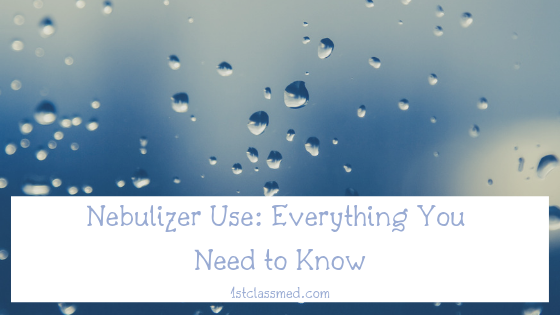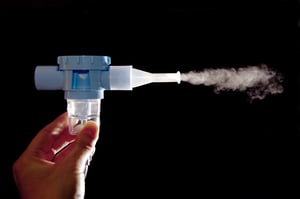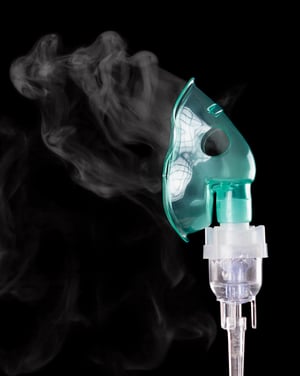
For those with asthma, a nebulizer may be prescribed as a treatment method or as a form of breathing therapy.
A nebulizer delivers the same type of medications as inhalers (MDIs), but they are often considered easier to use for children and those with severe asthma.
Nebulizers are often the same size as inhalers and may be easier to use than many metered-dose inhalers (MDIs).
The device uses liquid medication, turning it into a mist to help treat asthma.
It provides the user with quick, mist-form medication that helps relax the airways.
For small portable nebulizers, they are often electric (requiring to be charged) or battery operated (requiring replacing the batteries).
A larger size nebulizer is often used for home use, often meant to be placed on a table and plugged into the wall.
Both portable and larger nebulizers are made of a few parts, a base, air compressor, a holding tank for the medicine and a tube connected to the air compressor and the cup for medication.
There is also a mouthpiece or mask (depending on what form of nebulizer) that is used to inhale the mist.
They also require a prescription from your doctor, so speak with them if you think you could benefit from a nebulizer.
How to Use:
- Make sure you have all the parts for your nebulizer: air compressor, medication cup, mouthpiece/mask, medication and compressor tubing.
- After you have all of the supplies, place the compressor on a table, or counter that will hold the nebulizer.
- Before you go any further, wash your hands well before handling any medication
- Make sure all of the pieces are clean
- If your medication is premixed by the pharmacy, pour it into the medicine cup, if not, mix it yourself before pouring into the tank
- Attach the hose and mouthpiece to the medicine cup
- Turn on the nebulizer for a moment and check to make sure there is a light mist coming from the mouthpiece/mask, turn it back off
- Place the mouthpiece in your mouth, or place the mask tight against your face
- Sit straight up in a comfortable chair, or make sure you are standing straight
- Turn back on the nebulizer and take slow, deep breaths, holding each for 2-3 seconds before exhaling
- Continue to do so until all medication is gone, this can last from 5 to 20 minutes, averaging 10 minutes
- Once medicine is no longer coming through the mask or mouthpiece, turn off the machine
- Clean the medicine cup with water and air dry until you use the nebulizer again
How it Works:
Pressurized air works its way through the tubing, and as it does, it turns the liquid medication into a mist.
When it reaches the mouthpiece, and then the airways of the user, it can help open airways faster than other methods.
The science behind a nebulizer is based upon the Bernoulli Principle.
The theory of the Bernoulli Principle is that when a stream of liquid is pushed through a narrow opening, it creates a negative pressure.
This then creates a stream of air through the stream of a liquid, while the negative pressure sucks the liquid into the stream of air, which creates a mist.
When an individual is suffering from an asthma attack or a respiratory infection, the mist is easier to inhale than spray from an inhaler.
During an asthma attack the airways narrow, making it very hard to take deep breaths.
A nebulizer is an easier and more effective way to provide medication during an asthma attack.
Medications:
The medications used in a nebulizer come in liquid form, some come premixed, others may need to be mixed by the user.
The medication comes in single-dose bottles, called ampoules, that have easy twist off tops.
The contents of the ampoules are poured into the medication cup, often mixed with normal saline.
When mixed, there is commonly .5cc of medication combined with .3cc of normal saline.
Normal saline is used as it is sterile salt water and contains the same amount of salt as normal human body fluids.
It is also used because it does not cause any harm to the airways.
Cleaning the Nebulizer:
Not only should the nebulizer be cleaned after every use, but it should be thoroughly cleaned to prevent the spread of bacteria.
After use, remove the mouthpiece or mask from the nebulizer and set aside.
Remove the medicine cup as well, and wash with hot water and mild dish soap and rinse.
Reconnect to the container and attach the mouthpiece or mask to the compressor.
Once everything is connected, turn on the device to dry the pieces fully.
Disinfecting/Maintenance:
Remove all detachable parts from the device, mouthpiece or mask and medicine cup.
Soak in a solution provided by your doctor, or if they did not tell you how to clean it, use one part vinegar and three parts hot water.
Depending on instructions from your doctor, soak for up to an hour or however long is listed.
Once time has passed, remove the parts from the disinfectant and either let air dry or reattach to the nebulizer and turn on to dry.
When maintaining a nebulizer, parts may need to be replaced, such as the masks, filters and tubing.
Follow all manufacturers’ instructions when dealing with parts and part replacements.
Depending on the nebulizer masks, you will need to replace them either every 5-7 uses if they are disposable, or regular masks last up to 6 months.
Plastic degrades over time and over-use of a mask can reduce treatment benefits.
When purchasing a new mask for your nebulizer, make sure it is compatible with your nebulizer.
Your nebulizer filter should be replaced as often as the instructions say to do so, if you cannot find the instructions, replace the filter when it turns to a dark grey color (appearing dirty).
For those who live near a busy road, farm or anywhere where extra dust/dirt is you may need to replace the filter more often, so check monthly.
Tubing may need to be replaced, this should also be listed in the manufacturers’ instructions, if not, plan to replace whenever you notice cracks or tears in the tubing.
Keep extra parts in case any parts that are in use, break.
Extra mouthpieces/masks, filters and tubing should all be kept on hand in case any parts break and you may be in urgent need of the nebulizer.
Conclusion:
Nebulizers are great for those with asthma, or other respiratory conditions.
Used for young children, or for those in the middle of a very serious asthma attack, nebulizers can be lifesaving.
It supplies liquid medication (in mist form) to those who are in need of medication very quickly.
When cleaning the nebulizer, make sure to clean after every use, and disinfect at least once a week to prevent growth of bacteria.
Parts may also need to be replaced, such as the mask/mouthpiece and tubing.
Speak with your doctor if you feel you could benefit from a nebulizer, or if you need help with yours.



